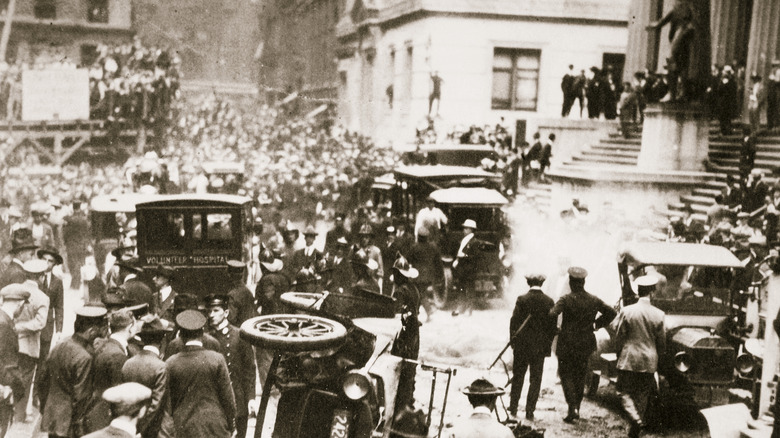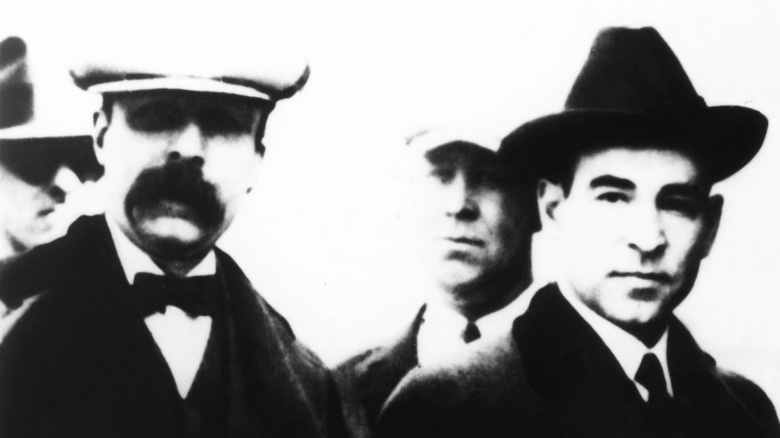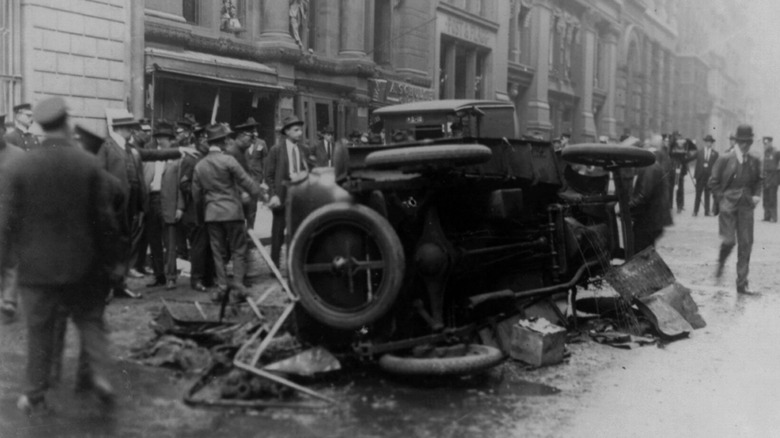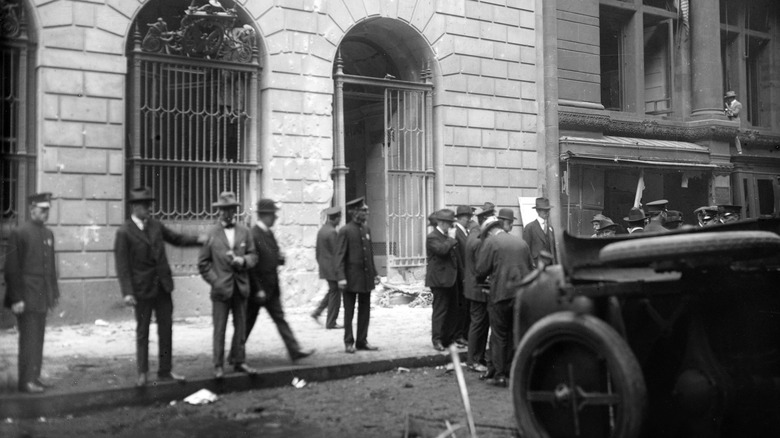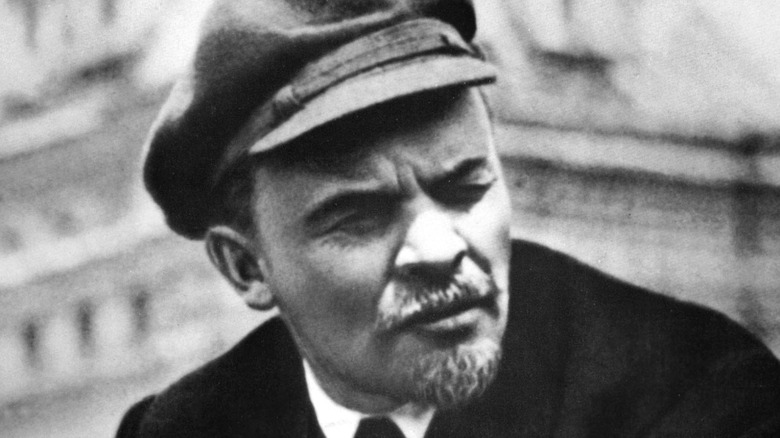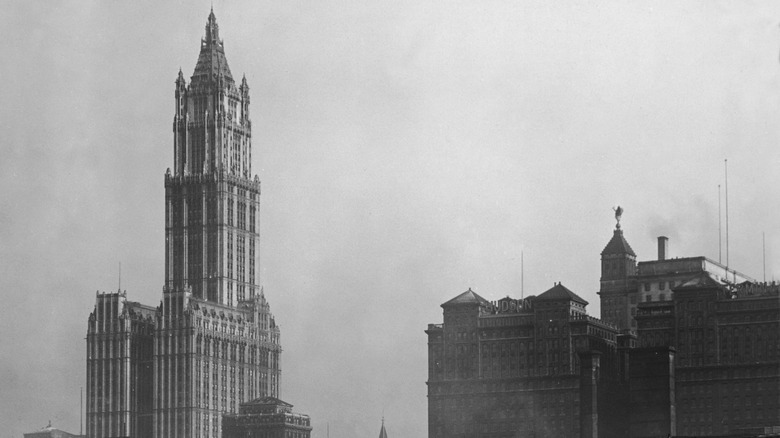The Biggest Theories About The Wall Street Bombing Of 1920
On September 16, 1920, an explosion from a bomb planted inside a horse-drawn cart on Wall Street near the New York Stock Exchange killed 38 people and injured hundreds more, according to Britannica. More than 100 years later, the lower Manhattan attack remains unsolved, despite being considered New York City's worst terror attack before 9/11 (via CBS News).
Because the cart was planted in front of the J.P. Morgan & Co. building, investigators initially considered the possibility that the attack was an attempted assassination of financier J.P. Morgan Jr., but he was in Europe at the time of the bombing. When investigators discovered that anarchist flyers had been dropped in nearby mailboxes, they became convinced that the bombing was the result of Italian leftists, who were likely responsible for previous terrorist attacks around the country, according to the FBI.
Though the case was never solved, it's very possible that investigators were correct, and that anarchists were to blame for the attack. But who, and why?
The anarchist theory
Today, the FBI says that the bulk of their evidence points to the bombing as the work of a small group of Italian anarchists. They were likely followers of Luigi Galleani, an Italian immigrant to America who wrote pamphlets on bomb-making and called for the "propaganda of the deed," in which anarchist ideas could be spread through violent attacks on powerful people (via Time).
Influenced by Galleani, radicals across the country were responsible for several smaller attacks, leading to the first Red Scare and the Palmer Raids, according to Slate. Galleani himself was deported back to Italy in 1919. Nicola Sacco and Bartolomeo Vanzetti (above), two Italian anarchists, were arrested in a murder case several months before the Wall Street bombings, in what was seen as a dubious charge by some contemporary observers (and historians), according to Britannica.
This perhaps explains the text on the flyers left on Wall Street immediately before the bombings: "Remember, we will not tolerate any longer. Free the political prisoners, or it will be sure death for all of you. American Anarchist Fighters" (via Time). The flyers were similar to others left behind at smaller Galleani-influenced bombings.
Revenge for Sacco and Vanzetti
An associate of Sacco and Vanzetti, the Galleanist Mario Buda, soon became a promising suspect in the Wall Street attack. Buda was a suspect in earlier anarchist bombings stemming from the lead-up to World War I, including a 1916 bombing at a parade in San Francisco that killed 10 (via New England Historical Society). Later that year, he was arrested for participating in an anti-war riot in Boston, and sentenced to five months in prison.
There is other evidence that points to Buda as the most likely perpetrator of the attack. A blacksmith told investigators that he had fit horseshoes for horses that matched the description of those used for the cart in the attack, according to the FBI. He said the customer he dealt with was an Italian man. And years later, Buda reportedly told his nephew Frank Maffi that he was responsible for the attack, according to "In Search of Sacco and Vanzetti," journalist Susan Vejada's book on turn-of-the-century radicals.
Buda, however, escaped to Italy before he could be arrested, where he remained until his death in 1963 (via The New York Times). He was never charged with the attack — no one was.
The man who saw it coming
There are theories, however, that the bombing had nothing to do with the anarchists. One suspect was the tennis champion Edward Fischer, who wrote letters to his friends warning them that there would be an attack on Wall Street in mid-September (via History).
Investigators interviewed Fischer four days after the attack, hoping to gain some clarity, according to a New York Times story from 1920. They asked the athlete how he had come to predict the date of September 15; he claimed that he thought it would be six months from the Ides of March, the anniversary of when Julius Caesar was killed. Fischer had claimed the attack would be at 2:10 p.m., he said, because he saw a friend shuffle cards and reveal the 10 of diamonds and the 10 of spades: two 10s.
Investigators soon dismissed him as mentally unstable. Fischer had made similar warnings in the past, and this one could be dismissed as a strange coincidence. Fischer wasn't arrested, and instead was sent to a sanitarium.
Was it the Soviets?
The Wall Street bombing came just months after the Palmer Raids, the first Red Scare in American history. The U.S. Department of Justice, led by Attorney General A. Mitchell Palmer, arrested and deported hundreds (possibly thousands) of immigrants suspected of radical leftism (via Britannica). Though some leftists, like the famed anarchist Emma Goldman, were deported, today historians believe that the majority of those caught up in the Palmer Raids were not radicals — just recent European immigrants, particularly from the newly created Russian Soviet Republic. By the time of the Wall Street bombing, the public had largely turned against Palmer and his campaign.
In a holdover from the anti-Soviet panic, however, early suspects of the Wall Street bombings included Russian leftist groups, including the anarchist group the Union of Russian Workers (via Beverly Gage's book "The Day Wall Street Exploded: A Story of America in its First Age of Terror"). Other leftist groups, such as the IWW (an international labor union) and various communist groups, were investigated for the bombing before investigators concluded Italian anarchists were the most likely perpetrators.
Or was it an accident?
Perhaps the most unnerving theory of all, however, is that no one at all was responsible — that it wasn't an attack at all, but merely an accident caused by a passing truck carrying explosives. Following World War I, New York City was in a construction boom, which also led to a huge market in dynamite, according to The New York Times. ”There were interviews saying, 'You always see carts of explosives going through this neighborhood and I always think, how dangerous,'" said historian Beverly Gage.
This might have been a likely theory if not for one thing: the remnants of shrapnel, specifically about 500 pounds of metal window-sash weights. "Most people who were killed or injured were hurt by shrapnel," said Gage in an interview with the New York Post. "The metal shards were packed in with the dynamite. It indicated that this was a deliberate bombing and not an accident. It was set off in front of J.P. Morgan to make a statement. They aimed at what J.P. Morgan stood for: capitalism in America."
